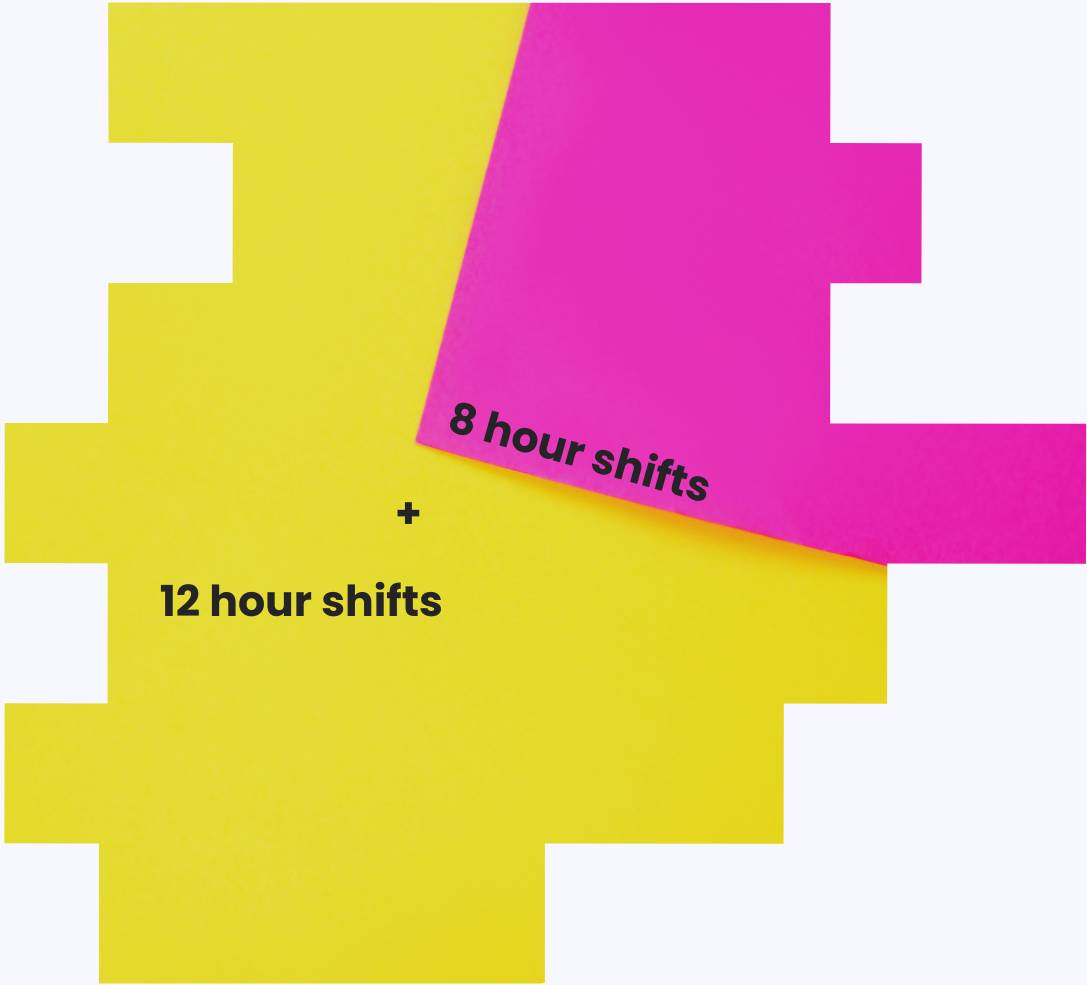12 hour shift patterns Vs 8 hour shift patterns
Exploring the ongoing debate
12 hour shifts Vs 8 hour shifts
A frequent discussion our shift work experts have with management teams, trade unions and shift workers is the relative benefits of 12 hours shift patterns and 8 hour shift patterns.
12 hour and 8 hour rotating shift patterns are common in 24 7 operations as they enable continuous coverage.
This article briefly looks at the pros and cons of both 12 hour shifts and 8 hour shifts and what you should looking at when changing shift patterns.
Advantages of 12 hour shifts - for employers
12 hour shift patterns are commonly used across many different industries.
In environments like manufacturing, emergency services and healthcare you’ll find a significant proportion of the front-line workforce are on 12 hour shift patterns.
12 hour shifts are often preferred to 8 hour shifts in many organisations for a number of reasons that span both performance and people.
For employers, the advantages of 12 hour shifts include:

Changeovers
Dividing labour supply into two equal 12 hour shifts makes it easier to manage shift changeovers compared to 8 hour patterns.
Having two handovers per day (instead of three for 8 hour shifts) reduces the likelihood of disruptions to production or service levels that can happen because of communications errors at changeover.
Error-free transition between 12 hour shifts is crucial to productivity. In emergency services vehicle capacity can be impacted by having more handovers per day with the risk of over-running shifts.
Performance
Longer shifts such as 12 hour shifts can drive performance compared to 8 hour shifts as they allow for a longer duration of process.
For example, there is often a period at the start of shifts where productivity is naturally lower as your shift workers handover and then ‘ramp up’ as they move towards peak efficiency within the shift.
With a 12 hour shift pattern you can ensure they are at this higher performance level for longer…increasing output and productivity and ensuring tasks are completed (or well progressed) before shift handover.
Support
12 hour shift patterns can bring wider operational benefits as the lower number of changeovers makes shift work easier to manage and administer than with 8 hour shifts.
Your managers and Workforce Management Systems (WFM) will have to deal with much less complexity when it comes to rostering, scheduling and time and attendance.
Estates and logistical considerations are also simplified with 12 hour shifts, as there much less comings-and-goings on site over any 24 hour period.
Employee relations
Many shift workers have a strong preference for 12 hour shift patterns over 8 hour shifts due to the varied benefits it provides them (see next section).
This can translate into higher job satisfaction, reduced absenteeism, strong retention and provide a compelling component in recruitment.
A significant proportion of organisations also anecdotally report improvements in morale and satisfaction with 12 hour shifts.
Shift Patterns
Finding shift patterns that balance the needs of your organisation and shift workers can be a slow and painful process.
optashift’s Shift Pattern Design service combines data science, expert insight and collaboration to create shift patterns that are fully optimised for your performance and people.

Advantages of 12 hour shifts - for shift workers

12 hour shift patterns can often divide opinion.
For some (particularly those more used to 8 hour work days), 12 hour shifts or rotational shift work in general is simply not compatible with their lifestyle.
However, there are also a significant number of shift workers who find 12 hour shifts deliver significant benefits that 8 hour shifts can’t provide.
In our experience many shift workers resist moving to an 8 hour shift pattern if they have experienced working 12 hour patterns as they become used to this way of working and the lifestyle it enables.
Every shift worker is different, but the commonly expressed advantages of 12 hour shift patterns include:
Presences
Whilst 12 hour shift patterns require your shift workers to be at work for a longer period while on shift…overall they require colleagues to attend work less times than 8 hour shifts.
This includes fewer consecutive days worked, with consecutive runs of shifts typically lower than with 8 hour shift patterns.
This can help support an individual’s preferred work-life balance. You can implement considered shift start and finish times to further support ‘usable’ leisure or family time.
Having to be at work less times throughout the year also reduces the time and cost impact of commuting for shift workers.
It also ensures individuals have more scope to organise other commitments such as healthcare appointments and childcare.
Total time off
One of the key advantages of 12 hour shifts in 24 7 operating environments is the number of days and weekends shift workers have off work.
In 24 7 environments, 12 hour shift patterns result in significantly fewer shifts across the year and 50% as many clear weekends than equivalent 8 hour shifts.
Aligned to the number of presences at work, the total rest days are 50% greater for 12 hour 24 7 shift workers compared to the equivalent 8 hour shift pattern.
Nature of the time off
12 hour shift patterns potentially enables more beneficial arrangement of leisure time than 8 hour shift patterns, as they provide increased days off, consecutive days off and weekends off.
Known as ‘white space’, the volume and spacing of non-working days provides more scope to use time off effectively.
This allows shift workers to fully switch off from work which can aid rest, recuperation and lowers stress.
Through optimised shift pattern design you can combine ‘white space’ with annual leave to create multiple extended periods of time off throughout the year.
What are the negatives of 12 hour shifts?
By their nature 12 hour shifts require individuals to work long hours, which brings a set of challenges that need to be managed.
Like any shift work system, you need to tailor and apply best practice to ensure risks are mitigated, opportunities maximised and that 12 hour shifts are designed, implemented and maintained in the best possible way for your organisation and workforce.
Compared to 8 hour shifts, some of the perceived negatives of 12 hour shifts include:

Demographic fit
Some people are unable to work 12 hour shifts due to their personal circumstances. For individuals with caring commitments or older workers with engrained work and social routines, 8 hour shifts are often preferrable.
This can create recruitment and retention issues for employers and ultimately lead to a constrained labour pool and less diverse workforce.
Whilst 8 hour shifts may be more attractive to certain people, it’s worth remembering that 12 hour shift patterns can be designed to be made more suitable for different demographics through solutions like term-time patterns.
Shift work fatigue risk
Shift work fatigue is a complex topic covered in detail elsewhere on our website.
Naturally long hours and night shifts can be contributory factors in shift work fatigue. However they are not always the sole cause, nor is fatigue risk exclusive to 12 hour shift patterns.
Other factors which have a significant impact include the nature of the work, the speed of shift rotations and the individual profile and tolerances of shift workers.
An additional factor for you to bear in mind is the fatigue risk around 12 hour shift patterns can be impacted by long commutes. Just an hour’s journey to and from work results in a 14 hour day.
This can increase the risk of fatigue-related driving accidents and leaves little time to unwind or meet personal commitments before or after the shift.
It’s worth noting that shift work fatigue risk can still be an issue with 8 hour shifts in 24 7 environments, as a proportion of the hours worked will be at night.
In some environments you will also see back-to-back 8 hour shift patterns being worked to provide last minute cover. This takes total hours worked to 16 and therefore significantly increases shift work fatigue risk.
Communications and engagement
12 hour shift patterns require you to carefully consider how and when employees receive communications.
Unlike 8 hour shifts, it’s often not possible to tag meetings or briefings onto a shift…or ask shift workers to come in for an hour or so on a rest day.
It’s also important for you to consider that 12 hour shift patterns will naturally create longer periods when an employee is not in contact with their manager or colleagues compared to 8 hour shifts.
Your shift pattern design process should take into account the need for shift workers to effectively ‘re-connect’ with the organisation and the requirements and interdependencies this creates.
Physical impact
Roles that are physically and mentally demanding can be made even more challenging if high intensity work is required across a 12 hour shift.
Longer shift lengths can increase the risk of errors, accident and injuries if no shift work solutions are put in place to mitigate it.
Organisations should look at elements such as in-shift task scheduling, break frequency and break discipline to counter this risk.
You also need to have good governance around rest periods, overtime and annual leave.
Progressive employers are increasingly exploring additional health and wellbeing support for those working 12 hour shifts, including enhanced monitoring, targeted interventions and applying human factors best practice in process and task design.
Sleep
Rotating shift patterns in 24 7 environments require night shifts regardless of whether they use 12 hour shifts or 8 hour shifts.
By their nature 12 hour shift patterns reduce flexibility around when sleep can occur. Shift workers therefore need to condition themselves to go to sleep in the morning and continue this into the early afternoon after a 12 hour night shift.
This can prove difficult due to individual physiology/chronotype and increased noise and natural light during the daytime.
You also need to consider shift pattern rotations. How the body moves from days to nights needs to be accounted for with appropriate rotation speed and recovery time factored into both 12 hour shift patterns and 8 hour shift patterns.
In any 24 7 shift working environment it’s worth considering what sleep hygiene support you provide to shift workers to help them better understand the challenges and manage their rest and recouperation in a way that suits their personal chronotype and physiology.
Shift work nutrition
12 hour shifts span multiple mealtimes, so it can be difficult for shift workers to achieve a balanced nutritional and calorie intake during this time.
It’s important the principles of chrononutrition are understood by both your organisation and shift workers.
This means ensuring that your on-site catering facilities (restaurants, canteens or vending solutions) are serving appropriate options at the right time of day.
You need to make adequate solutions available for employees to store food and drink they have brought in, or to secure appropriate snacks and refreshments throughout the shift.
It’s also key that your shift workers are given the kind of guidance and support that helps them make informed choices.
You can find out much more on this topic in our shift work nutrition overview.
Cover flexibility
Whereas it is relatively easy to extend an 8 hour shift to respond to changing circumstances, the options to extend 12 hour shifts is much more limited.
The start or end of an 8 hour shift can be extended by 2 hours to provide cover from within teams that are already on shift.
With 12 hour shifts you will have to call in an individual on their rest day. Working Time Regulations mean that a 12 hour shift pattern should only be extended by one hour to 13 hours.
You also need to be aware of the need to consider compensatory rest periods and ensure there is a minimum 11 hour gap between shifts.
For longer notice cover it is also often much easier to find colleagues willing to cover by extending an 8 hour shift rather than for attending on a rest day for 12 hour shifts.
Management
There are a number of potential management challenges associated with 12 hour shift patterns.
You need to carefully monitor and manage performance as long shift length can impact productivity.
Night shifts and the volume and spacing of non-working days often leads to long periods of time when managers do not see employees face-to-face reducing vital contact time.
The volume of non-working days provided by 12 hour shift patterns can also lead to shift workers stockpiling annual leave, which may create capacity issues for you at certain points in the year.
In some cases employees have structured second jobs around their days off, which often leads to over-employment…impacting productivity, shift work fatigue risk and Working Time Regulations compliance.
Mixing 8 and 12 hour shifts

This article has already looked at the relative advantages and disadvantages of 12 hour shift patterns compared to 8 hour shift patterns.
There really is no one right answer to which is best.
It depends on so many factors such as your organisation, the volatility of demand, the nature of the work, the demographics within the workforce…and a wide range of other variables.
In some cases it might be that mixing 8 and 12 hour shifts will provide the optimal solution for your 24 7 operations.
You see a combination of 8 hour shift patterns and 12 hour shift patterns in the 8 plus 12 shift schedule that is designed to provide 24 7 coverage.
With this system teams work a combination of three 8 hour shifts on weekdays and two 12 hour shifts on weekends, with fast rotation over the shift roster.
Your organisation could also have a mix of 8 hour and 12 hour shifts within a family of shift patterns across the operations.
Offering a combination of shift lengths by having both 8 and 12 hour shifts could help support recruitment and retention by making different shift patterns available that meet colleagues’ needs as they progress through different life stages and lifestyles.
Shift Work Assessment
Optimising shift patterns and shift work delivers huge benefits…but complexity and competing priorities sees many organisations leave things as they are.
Our Shift Work Assessment is a streamlined process which quickly analyses all relevant operational and HR factors to give you a tailored plan for immediate improvement.

The role of shift work data
What is the best shift pattern?
Well it depends on whose asking!
When you compare 12 hour shifts to 8 hour shifts there is often a lot of subjective views, preconceptions and ‘gut feel’ involved.
It’s important to use shift work data to analyse the facts as they relate to your individual organisation and its shift workers.
Only then can you establish an objective view over which shift pattern will be best at balancing the needs of all stakeholders.

Using the shift | View tool, our data experts consider a wide range of variables (and how they interact) when assessing shift patterns, shift work management and shift worker support.
Some of the key areas they explore include:
Demand
Do you have variable demand but shift patterns which provide a flat supply of labour?
Understanding true demand variability and operationalising this data by overlaying the constraints on labour supply is key to identifying optimal shift patterns.
Whether demand varies or not, labour supply will vary…so it is important for you to understand the profile of all types of absence (holidays, sickness etc).
Performance
How do productivity, service levels, overtime and other key metrics align to your shift patterns?
Are there clear trends or differences when you look at the impact of shift patterns over the day, month and year…or by team, location and role?
Employee requirements
Can you identify commonality within your workforce around sentiment and preferences when it comes to shift patterns and shift work?
What do people want…and are there distinct groupings which may inform your shift pattern design process?
Sickness absence
Are there indications in your data that the shift pattern could be a contributing factor in sickness absence?
It might be that rotations, rest periods and annual leave assignment are contributing to increased absence at certain periods of the year and that best practice shift pattern design, shift work management and shift worker support can help with absence prevention.
The importance of shift pattern design

In 24 7 operations not all 12 hour shifts or 8 hour shifts are the same.
Whilst the shift length is set, there are countless ways you can arrange these shifts into a pattern that balances operational requirements and employee preferences.
How you approach shift pattern design is therefore vital in the 12 hour shifts Vs 8 hour shifts debate.
It’s important to have an open mind and to be creative in the way you develop different shift pattern options.
This includes involving stakeholders from across the organisation in the shift pattern design process.
Our experts use the visualisation capabilities of our shift | Plan tool to enable collaborative shift pattern design.
By co-designing shift patterns in a transparent and interactive way you’ll be able to quickly identify the best shift patterns for you and your shift workers.
Shift worker support
As detailed earlier, shift work in 24 7 environments places additional health and wellbeing responsibilities on employers, regardless of whether they are operating with 12 hour shift patterns or 8 hour shift patterns.
You should look at the potential impact of shift patterns in the context of your specific shift work environment and demographics of your shift workers.
Whether it’s physical conditions, mental health, sleep, exercise, nutrition or relationships…there’s a lot you can do to put in place tailored support frameworks.
These programmes can span strategic, operational, technical and educative solutions to help address some of the potential negative impacts of 12 hour shift patterns and 8 hour shift patterns.
Ultimately this proactive approach will do more to help you lower sickness absence, improve productivity and support recruitment and retention than just altering shift length alone.

Shift Work Health
The effects of shift work on physical and mental health are clear…so responsible employers need to provide shift workers with tailored support across sleep, nutrition, exercise and social issues.
optashift will help you deliver a programme that blends strategic, operational, practical and technical solutions that are designed in collaboration with your workforce.

Ask an expert about 12 hour shifts Vs 8 hour shifts
optashift experts can help you identify the best shift pattern for your organisation.
Using unique shift work analytics and shift pattern design tools we can help you weigh up the advantages and disadvantages of 12 hour shifts and 8 hour shifts.
We’ll also help you engage your workforce to ensure their needs and preferences are taken into account.
Get in touch if you’d like to discuss 12 hour shift patterns Vs 8 hour shift patterns with our experts.
Shift Pattern, Shift Work and Shift Worker services

optashift services help you attain optimum shift work performance.
They can be delivered individually or combined to create a unified programme of continuous improvement.
Our agile approach means everything we do is tailored to your organisation and shift workers.
Shift work is complex, sensitive and always changing.
Let optashift be your trusted partner.
Our experience












